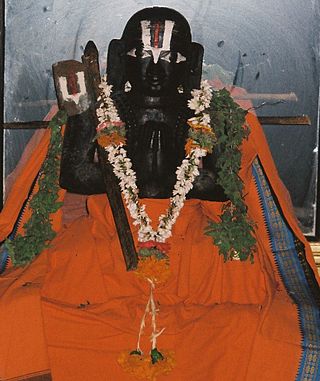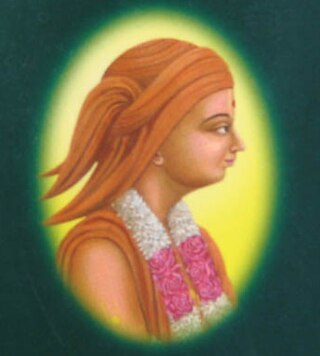Vedanta, also known as Uttara Mīmāṃsā, is one of the six orthodox (āstika) traditions of textual exegesis and Hindu philosophy. The word "Vedanta" means "conclusion of the Vedas", and encompasses the ideas that emerged from, or aligned and reinterpreted, the speculations and enumerations contained in the Upanishads, focusing on either devotion or knowledge and liberation. Vedanta developed into many traditions, all of which give their specific interpretations of a common group of texts called the Prasthānatrayī, translated as "the three sources": the Upanishads, the Brahma Sutras and the Bhagavad Gita.

Vishishtadvaita, is a school of Hindu philosophy belonging to the Vedanta tradition. Vedanta refers to the profound interpretation of the Vedas based on Prasthanatrayi. Vishishta Advaita, meaning "non-duality with distinctions", is a non-dualistic philosophy that recognizes Brahman as the supreme reality while also acknowledging its multiplicity. This philosophy can be characterized as a form of qualified monism, attributive monism, or qualified non-dualism. It upholds the belief that all diversity ultimately stems from a fundamental underlying unity.

Ramanuja, also known as Ramanujacharya, was an Indian Hindu philosopher, guru and a social reformer. He is noted to be one of the most important exponents of the Sri Vaishnavism tradition within Hinduism. His philosophical foundations for devotionalism were influential to the Bhakti movement.

Madhvacharya, and also known as Purna Prajna and Ānanda Tīrtha, was an Indian philosopher, theologian and the chief proponent of the Dvaita (dualism) school of Vedanta. Madhva called his philosophy Tattvavāda meaning "arguments from a realist viewpoint".
Jagadguru Swami Ramananda or Ramanandacharya was a 14th-century Vaishnava devotional poet saint, who lived in the Gangetic basin of northern India. The Hindu tradition recognizes him as the founder of the Ramanandi Sampradaya, the largest monastic Hindu renunciant community in modern times.

Mystic India is a 2004 large format film about India's culture, people, and traditions. It is told through the 12,000 km barefoot journey throughout 18th century India undertaken by the Hindu adolescent ascetic Nilkanth, later known in life as Swaminarayan by his followers. The film was directed by Keith Melton and financed and produced by BAPS Charities. The film is available in Hindi, English, French, and Spanish.

The Daśanāmi Sampradaya, also known as the Order of Swamis, is a Hindu monastic tradition of "single-staff renunciation" Ēkadandis were already known during what is sometimes referred to as "Golden Age of Hinduism". According to hagiographies composed in the 14th-17th century, the Daśanāmi Sampradaya was established by Vedic scholar and teacher Adi Shankaracharya, organizing a section of the Ekadandi monks under an umbrella grouping of ten names and the four cardinal mathas of the Advaita Vedanta tradition. However, the association of the Dasanāmis with the Shankara maṭhas remained nominal.

Swaminarayan, also known as Sahajanand Swami, was a yogi and ascetic believed by followers to be a manifestation of Krishna or the highest manifestation of Purushottama, around whom the Swaminarayan Sampradaya developed.

Gunatitanand Swami, born Mulji Jani, was a prominent paramhansa of the Swaminarayan Sampradaya who was ordained by Swaminarayan and is accepted as the first spiritual successor of Swaminarayan by the Bochasanwasi Akshar Purushottam Swaminarayan Sanstha (BAPS). Born into a religious family in the small farming community of Bhadra in Gujarat, India, he first received religious education under his father's guru, Ramanand Swami, before encountering Swaminarayan and becoming a swami under him at the age of 25. He was revered for his spiritual discourses and divine service.

Muktanand Swami (1758–1830), born Mukunddas, was a swami and paramahansa of the Swaminarayan Sampradaya.

Gopalanand Swami (1781–1852) was a paramhansa of the Swaminarayan Sampradaya who was ordained by Swaminarayan. He worked and guided many followers to spread the Swaminarayan Sampradaya. The Swaminarayan Sampradaya believes that Gopalanand Swami is regarded as one of the yogis who attained the positions of Ashthangyog or the 8 fold paths in the field of sacred yog. It is also believed that Gopalanand Swami was appointed as the head of both Vadtal and Amdavaad Desh.

The Vachanamrut is a sacred text consisting of 273 religious discourses delivered by Swaminarayan from 1819 to 1829 CE and is considered the principal theological text within the Swaminarayan Sampradaya of Hinduism. Compiled by five of his senior disciples, Swaminarayan edited and approved the scripture. As followers believe Swaminarayan to be Parabrahman, or God, the Vachanamrut is considered a direct revelation from God and thus the most precise interpretation of the Upanishads, Bhagavad Gita, and other important Hindu scriptures.

Vaishnavism is one of the major Hindu denominations along with Shaivism, Shaktism, and Smartism. It is also called Vishnuism since it considers Vishnu as the sole supreme being leading all other Hindu deities, that is, Mahavishnu. Its followers are called Vaishnavites or Vaishnavas, and it includes sub-sects like Krishnaism and Ramaism, which consider Krishna and Rama as the supreme beings respectively. According to a 2010 estimate by Johnson and Grim, Vaishnavism is the largest Hindu sect, constituting about 641 million or 67.6% of Hindus.

Sri Vaishnavism is a denomination within the Vaishnavism tradition of Hinduism. The name refers to goddess Lakshmi, as well as a prefix that means "sacred, revered", and the god Vishnu, who are together revered in this tradition.

The Nimbarka Sampradaya, also known as the Kumāra Sampradāya, Hamsa Sampradāya, and Sanakādi Sampradāya, is one of the four Vaiṣṇava Sampradāyas. It was founded by Nimbarka, a Telugu Brahmin yogi and philosopher. It propounds the Vaishnava Bhedabheda theology of Dvaitadvaita (dvaita-advaita) or dualistic non-dualism. Dvaitadvaita states that humans are both different and non-different from Isvara, God or Supreme Being. Specifically, this Sampradaya is a part of Krishnaism—Krishna-centric traditions.

Sadh Vaishnavism, , is a denomination within the Vaishnavism—Bhagavata tradition of Hinduism. Sadh Vaishnavism was founded by thirteenth century philosopher-saint Madhvacharya, who developed the Tattvavada (dvaita) Vedanta sub-school of Hindu philosophy.

The Swaminarayan Sampradaya, also known as Swaminarayan Hinduism and Swaminarayan movement, is a Hindu Vaishnava sampradaya rooted in Ramanuja's Vishishtadvaita, characterized by the worship of its charismatic founder Sahajanand Swami, better known as Swaminarayan (1781–1830), as an avatar of Krishna or as the highest manifestation of Purushottam, the supreme God. According to the tradition's lore, both the religious group and Sahajanand Swami became known as Swaminarayan after the Swaminarayan mantra, which is a compound of two Sanskrit words, swami and Narayan.
Hindu denominations, sampradayas, traditions, movements, and sects are traditions and sub-traditions within Hinduism centered on one or more gods or goddesses, such as Vishnu, Shiva, Shakti and so on. The term sampradaya is used for branches with a particular founder-guru with a particular philosophy.

Akshar-Purushottam Darshan or Aksarabrahma-Parabrahma-Darsanam, "Akshar-Purushottam philosophy," is a designation used by BAPS as an alternative name for the Swaminarayan Darshana, Swaminarayan's view or teachings, to distinguish it from other Vedanta-traditions. It is based on Swaminarayan's distinction between Parabrahman and Aksharbrahman as two distinct eternal realities, which in this view sets Swaminarayan's teachings apart from other Vedanta-traditions. It is an essential element for the BAPS and its Akṣara-Puruṣottama Upāsanā ("worship"), in which Purushottam c.q. Parabrahman is present in a lineage of Aksharbrahman guru's, who are the abode (akshar) of God.

The Swaminarayan Bhashyam (Svāminārāyaṇabhāṣyam) is a five-volume Sanskrit bhashya, or commentary, on the Prasthanatrayi (Prasthānatrayī) - the ten principal Upanishads (Upaniṣads), the Bhagavad Gita (Bhagavadgītā), and the Brahmasutras (Brahmasūtras) - which establishes the principles taught by Swaminarayan as perceived by the BAPS.


















